After lengthy preparations, the renovation of the Chain Bridge began this year, which is expected to last until 2023. In recent weeks, the location of the cranes needed for the renovation has been established, scaffolding has been built, and the Danube riverbed has also been inspected. And today, the bridge was completely closed. In our article, we detail what work will be done on the bridge over the next year and a half.
1. The existing road track is going to be rebuilt
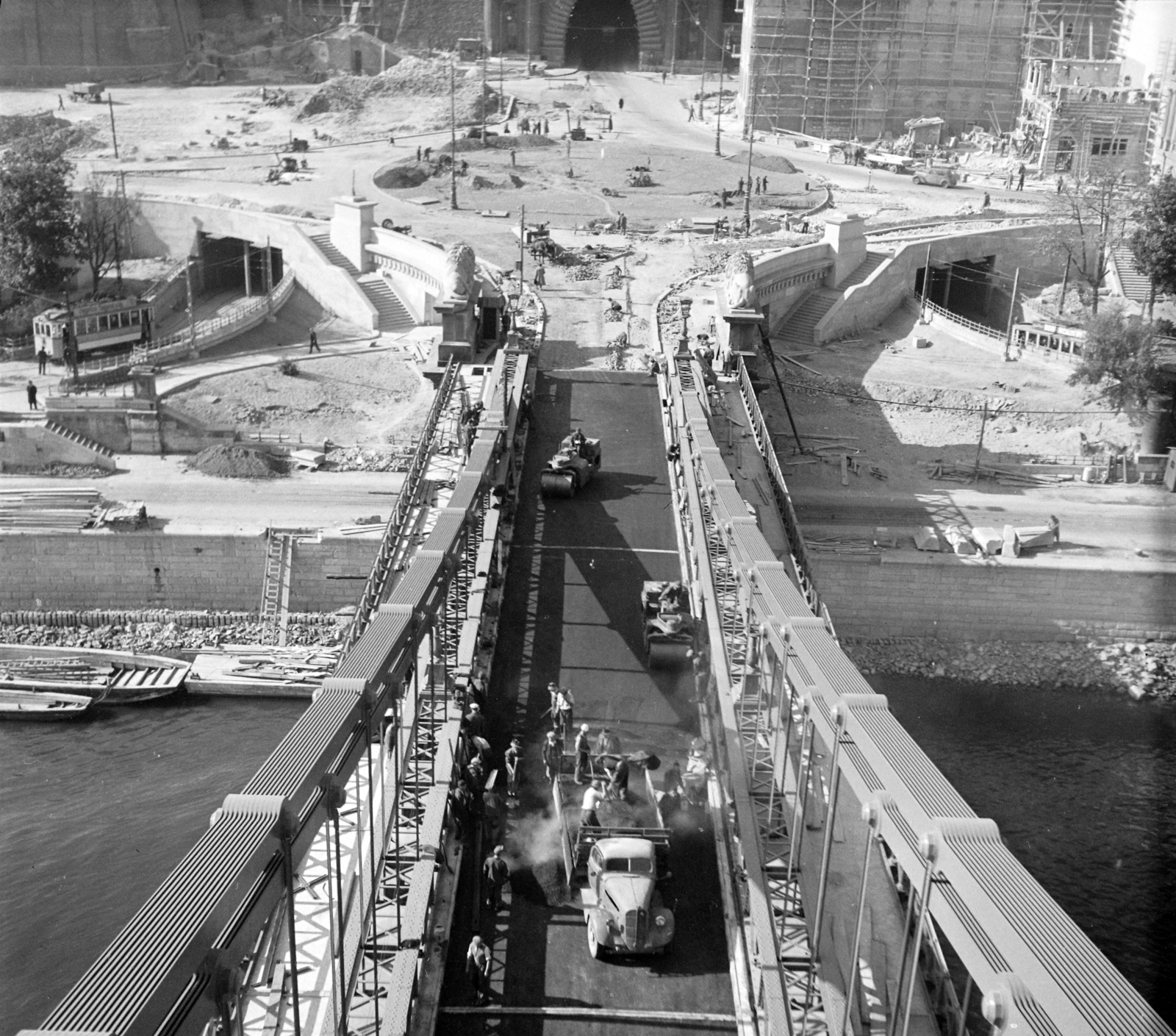
Construction of the Chain Bridge track in 1949 (Source: Fortepan / No.: 96616)
In 1915, the Chain Bridge was given a then standard track structure, which consisted of multi-layered concrete based on inverted gutter-shaped iron beams, "gutter irons", and a wooden cube cladding placed on it. The 1915 cladding was destroyed in a few years, so it was rebuilt in 1920. It was then that a small block-pavement was placed on the bridge, which was replaced with asphalt in 1929. During the reconstruction in 1947-1949, the then modern reinforced concrete track slabs were placed on the (also new) cross members supporting the bridge deck. Reinforced concrete is strong, withstands loads well, but breaks down over time due to winter road salting. The reinforced concrete has already been repaired during the 1973 and 1986-1988 renovations, but it is now completely demolished, and a modern, lightweight, steel-structured track slab is being made.
2. The remaining steel structures are going to be repaired and protected against rust
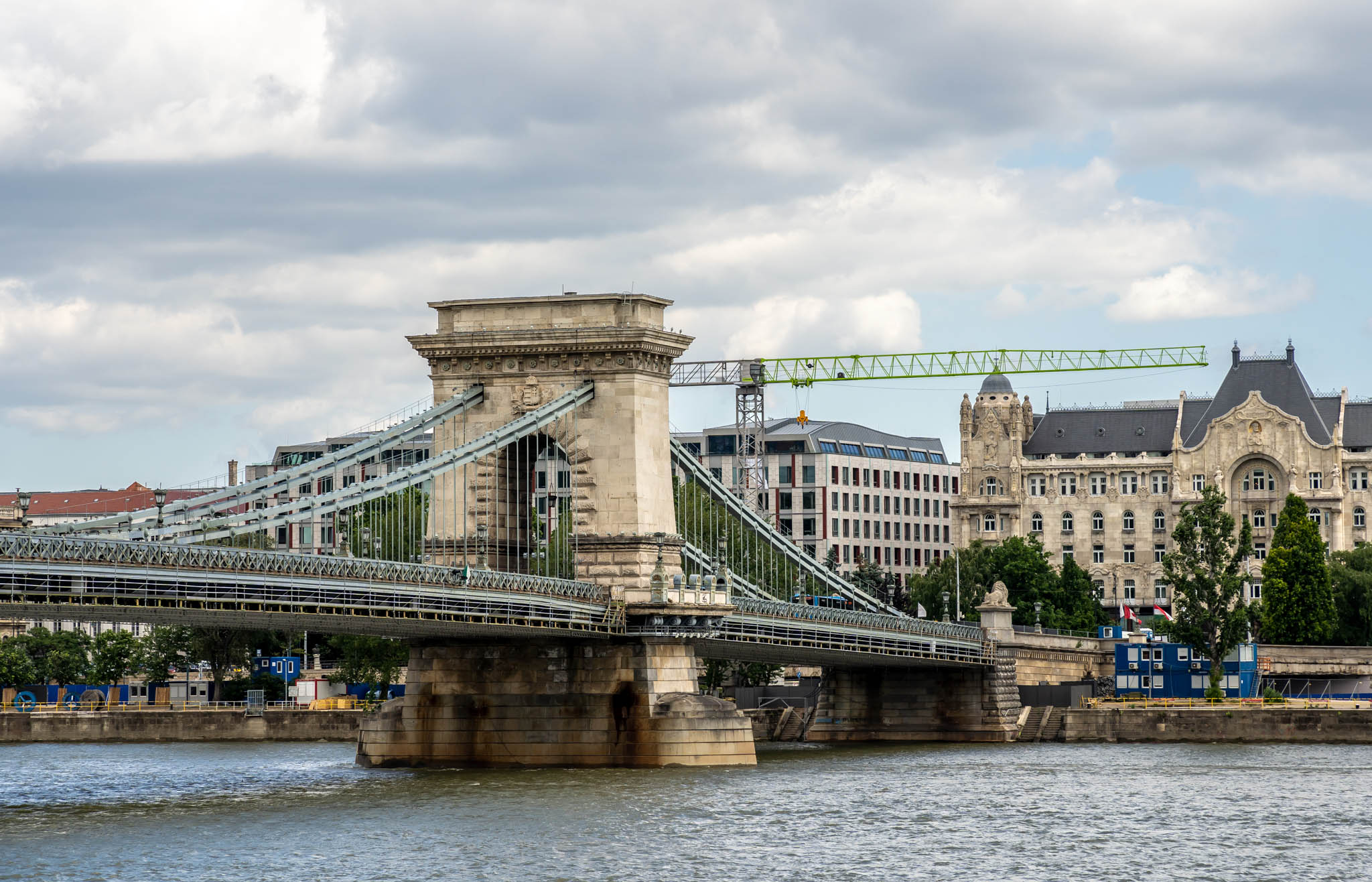
Preparations for the renovation of the bridge in the summer of 2021 (Photo: Balázs Both / pestbuda.hu)
The whole steel structure of the bridge - that is, what needs to be painted - is 73,000 square meters. Part of the steel structure, 70 per cent of the chains, were made in 1914-1915 and were reused after the bridge was blown up in 1945. A significant part of the other steel structures were made after World War II. Although the bridge has been painted several times since then, there is now significant corrosion on the structure. This is because salting strongly destroys the bridge, and the paint does not protect it perfectly either.
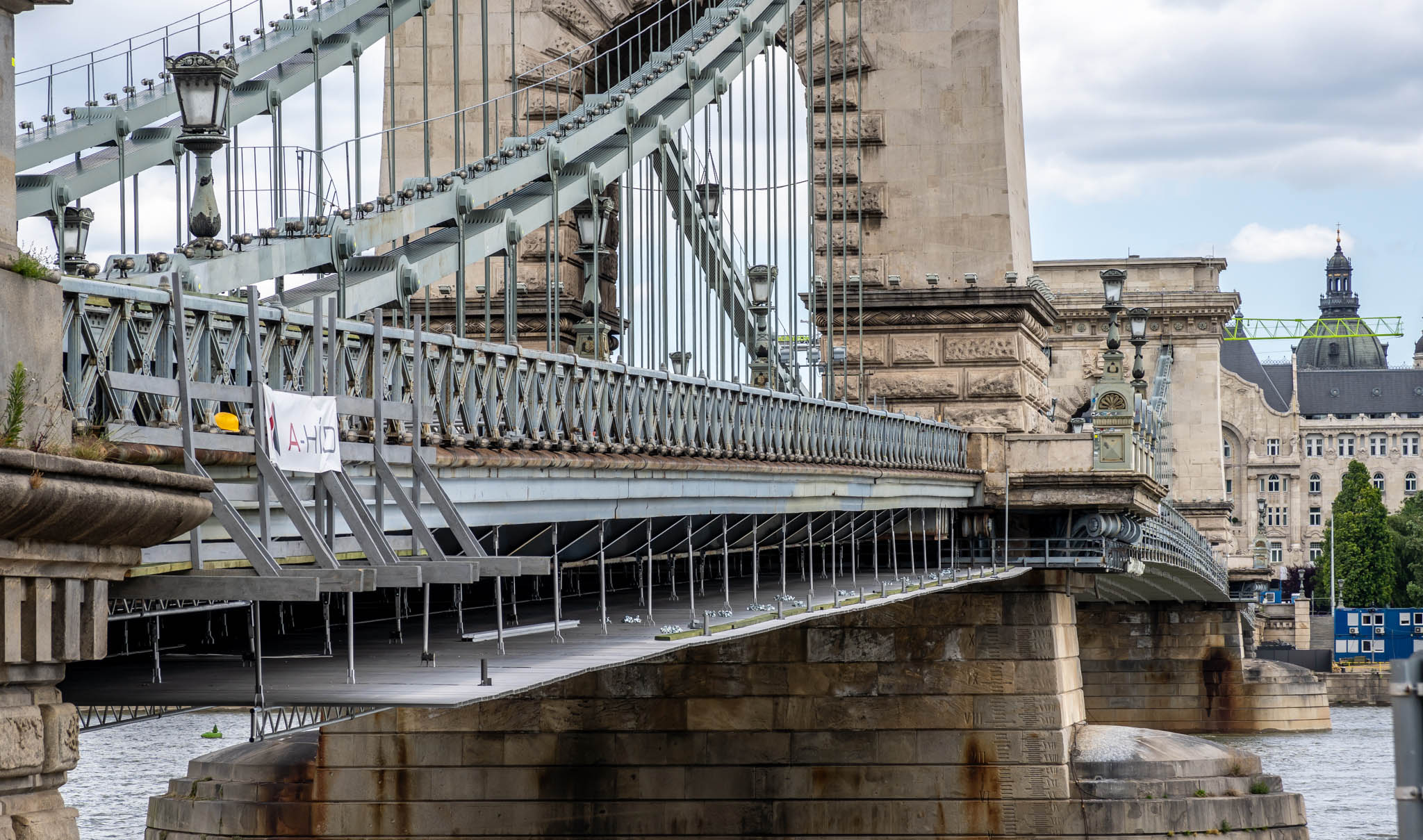
The railing of the Chain Bridge and the scaffolding that will be used during the renovation (Photo: Balázs Both / pestbuda.hu)
3. The sidewalks are going to be demolished and then rebuilt
The sidewalks are also being rebuilt and renovated. When planning the renovation, it was suggested that they be widened to 3 and 4 meters, respectively, but the bridge's structure would not really withstand the expansion. By the way, the sidewalks on the original bridge were even narrower than they are now because, on the 1849 bridge, they were only 1.8 meters wide. They were expanded to 2.2 meters during the reconstruction in 1914-1915. There were many complaints about them on the old bridge, they were narrow, and the simple plank flooring was slippery. In addition, strict traffic rules were in place. It was only possible to walk in one direction (on the right) on the sidewalks. It was forbidden to stop or turn around.
4. The monumental railings of the sidewalks are going to be renovated and restored
The railings were made in 1947-1949 in accordance with the previous conditions of 1915 and then remodelled in 1986-1988. Until then, the ornate cast-iron elements also had a support function. After the conversion, this is ensured by the closed section placed in the railing columns.
5. The underground anchoring chambers are going to be insulated, renovated, the ventilators on the Buda side are going to be rebuilt
The chains are anchored deep underground in both bridgeheads. This should be imagined as having 2-2 chambers underground, deeper than the water level of the Danube in Buda and Pest, with the side facing the river tilting slightly inwards. On this wall is the anchoring part that grips the chains, i.e., holds the entire bridge, the 5,000-ton structure.
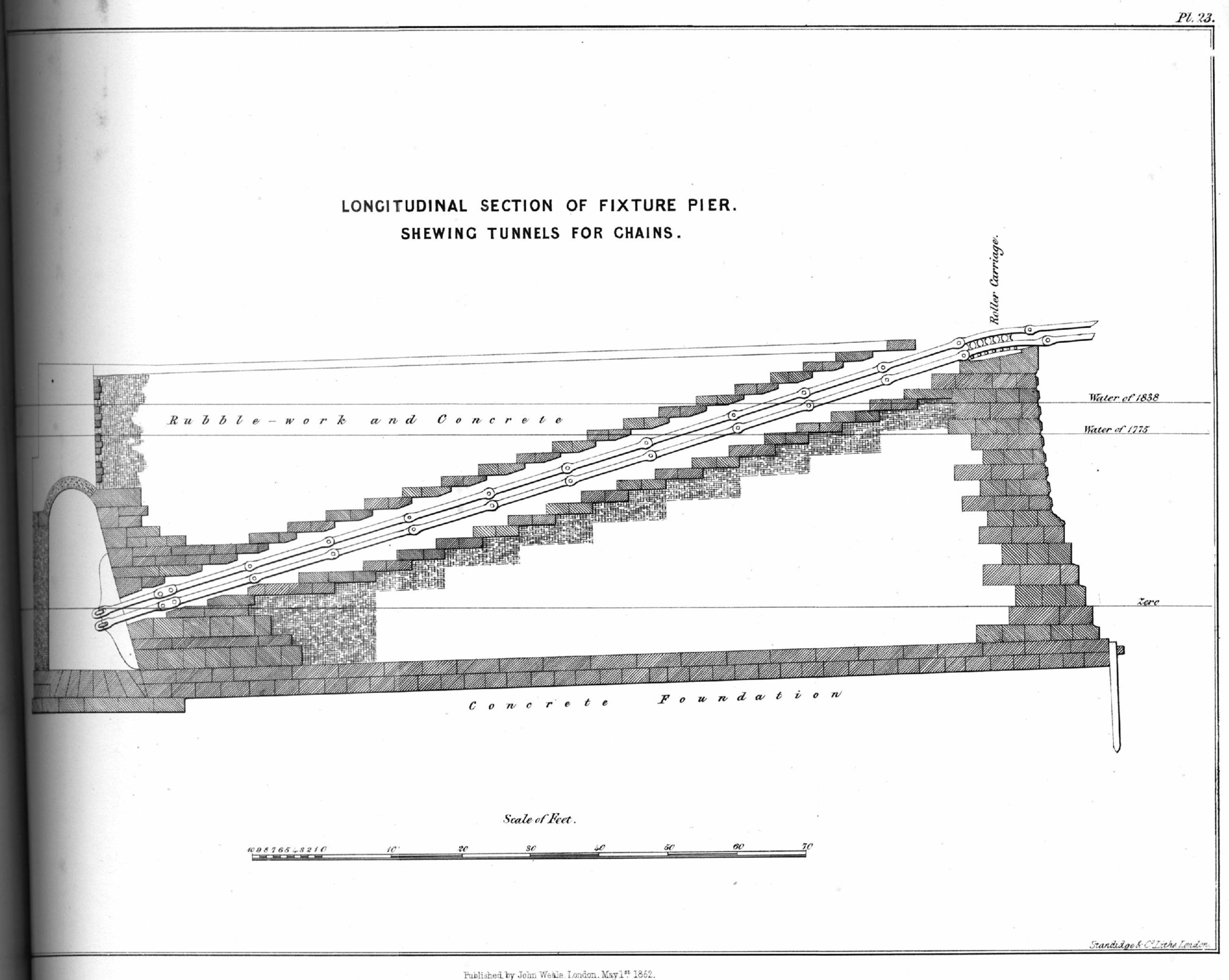
Design of anchoring chambers in W. T. Clark's 1852 book (Source: bpestchainbridgearchive.com)
In fact, the waterproofing of the chambers could never be solved. The water has always been leaking since the bridge was completed. It must be continuously pumped so that the feet of the workers in the chamber are not constantly wet, as the anchoring chamber, like the rest of the bridge, is constantly inspected. In addition, in the 19th century, a steel lattice was built a meter above the floor.
During World War II, the explosives placed in the chain chamber of Buda did not work because they were destroyed by the water accumulated in the chain chamber. On the Pest side, however, they exploded. Despite the fact that a lot of work was done on the insulation during the reconstruction, it did not work completely, i.e. the chain chambers are still wet, the air is humid and musty, so ventilation is especially important here, improving it plays a key role in protecting the bridge from corrosion.
6. The Danube flood protection system of the anchoring chambers is going to be built.
The entrances to the anchoring chambers, which could originally be accessed from the Customs House, now open from the pedestrian underpasses. However, these are below the flood level, so in the event of a flood on the Danube, the doors will be submerged, so their doors must close perfectly so that the Danube does not flood the anchor chambers.
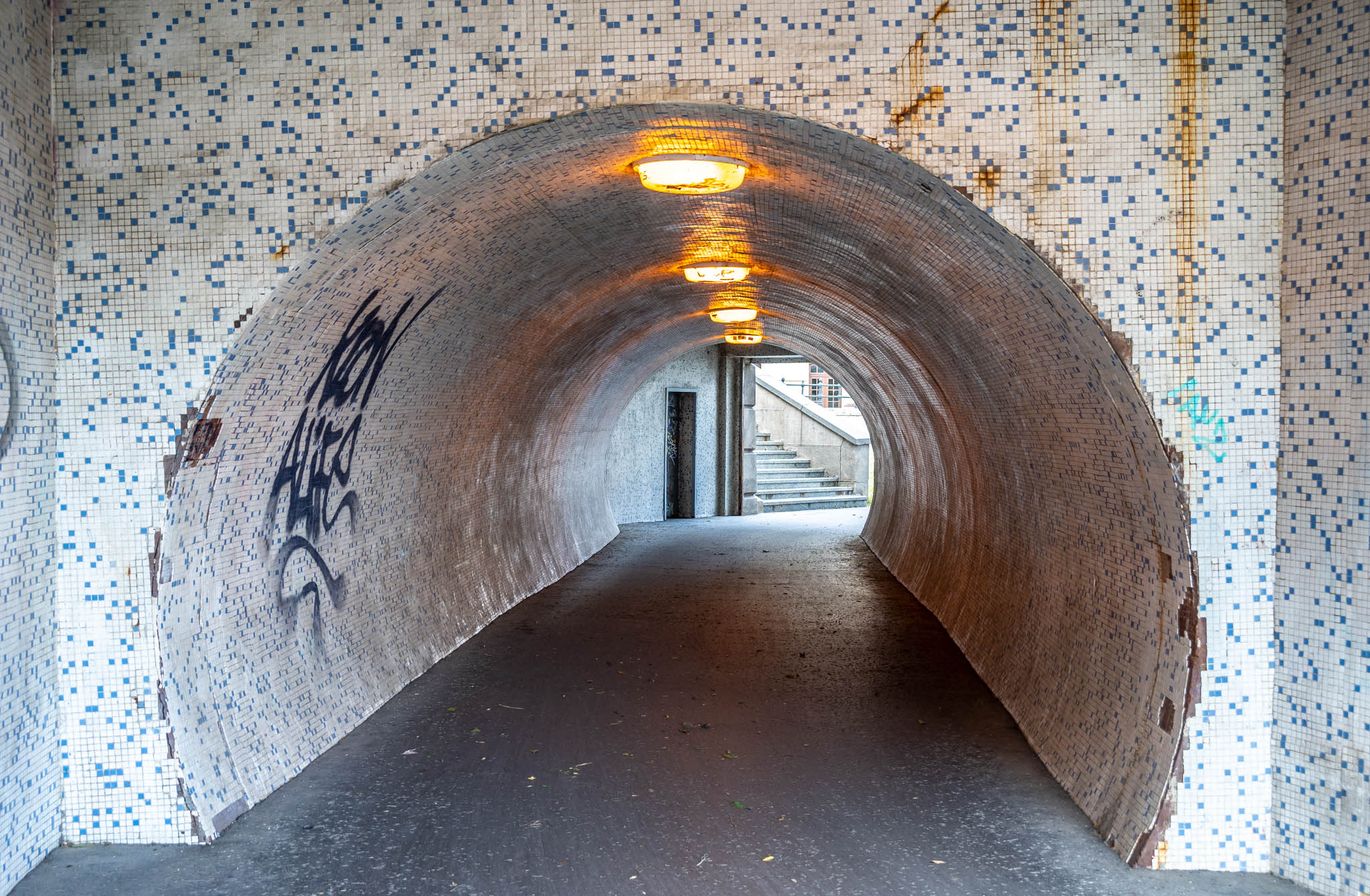
The small underpasses will also be renewed (Photo: Balázs Both / pestbuda.hu)
7. Pedestrian underpasses at bridgeheads are going to be widened, bridges at bridgeheads are going to be rebuilt, and premises are going to be renovated
The bridgeheads of the Chain Bridge used to stand on the banks of the Danube. With the design of the embankments, there was a need for bridgeheads to be permeable here as well. The pedestrian underpasses are therefore not the same age as the bridge. The one on the Pest side was built just before World War II, the one on the Buda side was built after the war, during the reconstruction.
8. The stone lions are going to be restored, and the missing monumental elements are going to be rebuilt
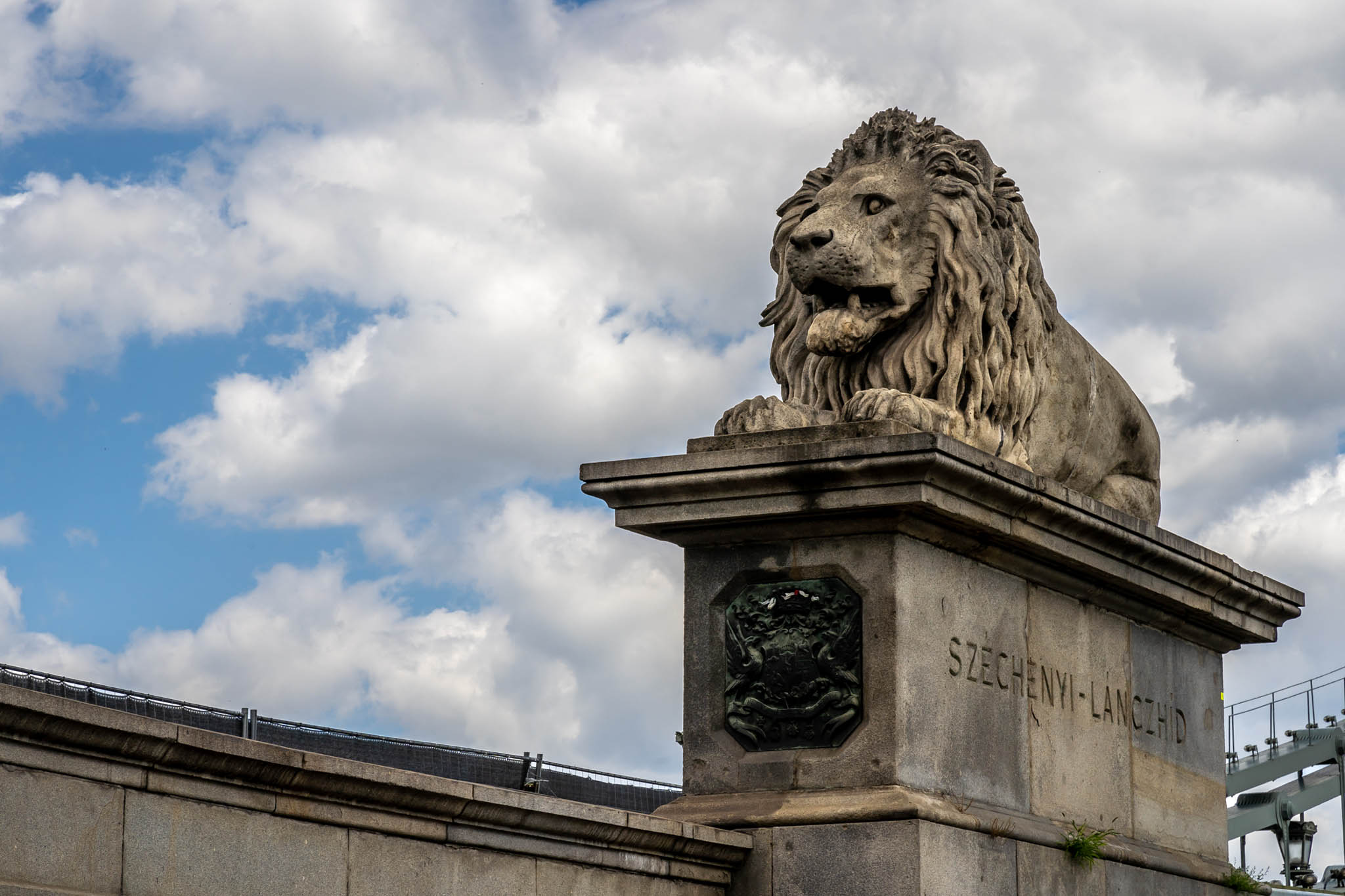
The famous lions have been guarding the bridge since 1849. They are going to be restored during the current renovation (Photo: Balázs Both / pestbuda.hu)
During the renovation, the stone lions are going to be restored. They - in contrast to data found in many other places - have actually been there since the bridge was opened in 1849. We have written in detail about the misconceptions about the stone lions - and the Chain Bridge - that can also be called the symbols of the bridge.
However, other monumental elements have changed, such as coats of arms. After the war, the Rákosi coat of arms was placed on the bridge in 1949, and the Kádár coat of arms in 1973, the originals were restored only in 1996. The candelabras were cast with the Kossuth coat of arms in 1949, so it remained on them, and it was not until 1986 that the Holy Crown, the laurel and the oak branch were retrofitted to each.
9. New LED street lighting and variable spectrum decorative lighting are going to be installed
The current decorative lighting was completed in 1999, for the 150th anniversary of the bridge. The first version caught fire on the bridge back in 1937, and then, in principle, decorative lighting was added to the bridge in 1949, but it did not work. In early 1966, the Socialist City Council commissioned the Building Engineering and Electrical Design Company to renovate, and the company wrote a letter to professionals asking for suggestions for lighting and even asking the public for ideas.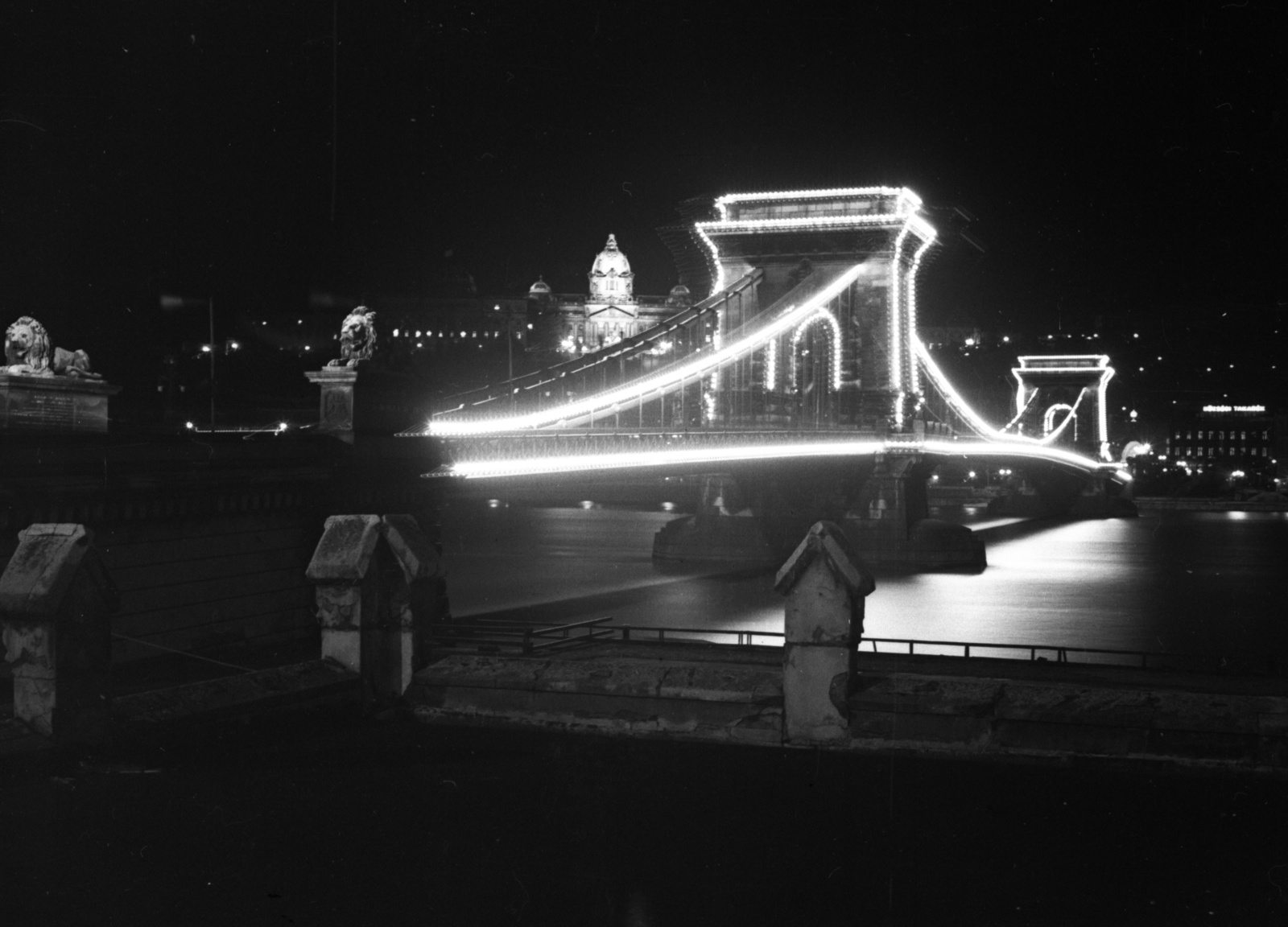
The original decorative lighting of the bridge in 1937 (Source: Fortepan / No.: 73195)
Nevertheless, in 1970, in a rush of work, with commercially available lamps (a total of 2,000 pieces), the decorative lighting was built to be completed by 4 April 1970, the 25th anniversary of the official day of "liberation". The rapid implementation was not successful either, as indicated in the internal information material of the Budapest Committee of the Hungarian Socialist People's Party in August 1972. In it, it is written that for the centenary series of events of the unification of the capital, the decorative lighting of the Chain Bridge, which had been out of operation until then, must be put into operation.
During the 1973 renovation, both the decorative and public lighting was renewed, and 400-watt sodium bulbs were installed on the bridge with a blind system. This was the second sodium lamp lighting system in Budapest. However, by the 1980s, this was also ruined and had to be replaced during the 1986-1988 renovation. At that time, five variants of the new decorative lighting system for the bridge were tested on the evening of 2 and 3 March 1987. The five versions were mounted on different parts of the bridge over a short section.
10. The flag-bearing bastions on the Pest embankment are going to be renovated
In fact, they do not belong to the bridge. They were built by the Danube Steamship Company in 1853 when ports were built both north and south of the bridge. The two bastions marked the end of the ports.
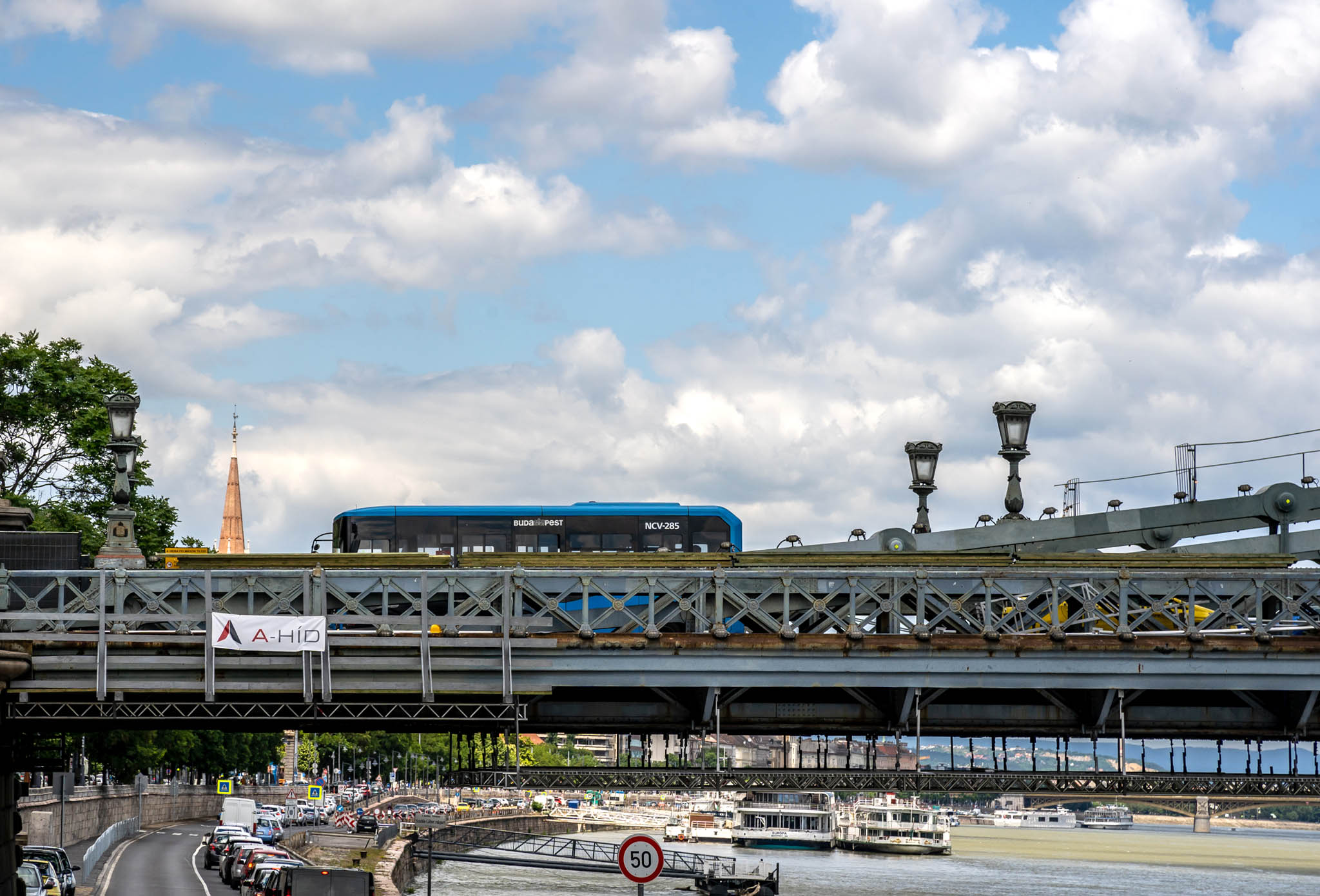
The ornate bridge is a bit worn by now (Photo: Balázs Both / pestbuda.hu)
11. A pedestrian crossing is going to be established between the northern and southern sidewalks of the Pest bridgehead
Pedestrian crossings have always caused trouble. Until the 1930s, it was only possible to walk on the sidewalks on the bridge in one direction. The strict rule was in force until October 1937, when the chief constable of Budapest allowed pedestrians to walk in both directions on Elizabeth Bridge and the Chain Bridge. This is because, at the bridgeheads, so many people crossed the road to the other side because of the mandatory direction of walking that it was dangerous. Although there is no longer a mandatory walking direction for pedestrians today, many still cross the road from one side to the other. A zebra crossing is going to make pedestrian traffic safer.
12. The utility lines on the bridge are going to be tidied up
A bridge provides crossings for cars and pedestrians and utilities, gas, electricity, or water lines, for example. A gas pipe - as early as the 1850s -later telegraph, telephone and other cables, were laid on the Chain Bridge, and there are still cables on it today, as well as a gas pipeline that is no longer used.

Vehicle traffic is expected in 2022, and pedestrians can only use the renovated Chain Bridge in 2023 (Photo: Balázs Both / pestbuda.hu)
The Chain Bridge is not only an iconic symbol of the capital but also part of our history. It took István Széchenyi's many years of determined work and the adoption of the Bridge Act to begin construction in 1840. One of the most outstanding technical works of the age was handed over in 1849. With the complete demolition of the old structure, a practically new bridge was built in 1914-1915, then in World War II, it was blown up by German troops and therefore rebuilt between 1947-1949. Most recently, it underwent a major renovation in the second half of the 1980s. The 172-year-old bridge is now being renewed again so that the wonder of the 19th century, one of the largest bridges in the world at that time, also holds its place in the 21st century.
Cover photo: The 172-year-old Chain Bridge before renovation (Photo: Balázs Both / pestbuda.hu)

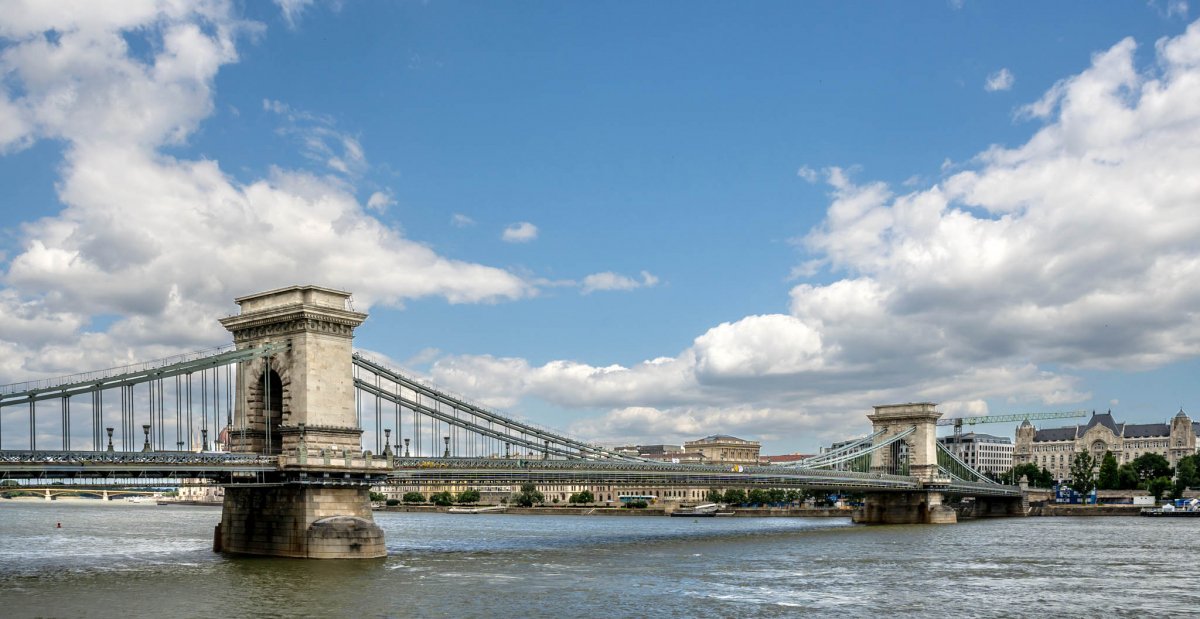

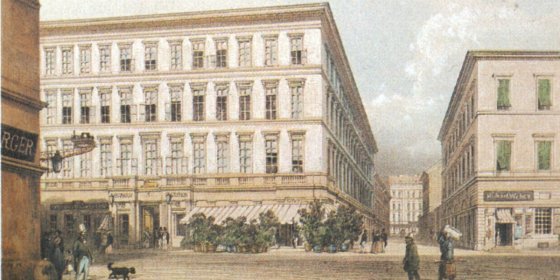

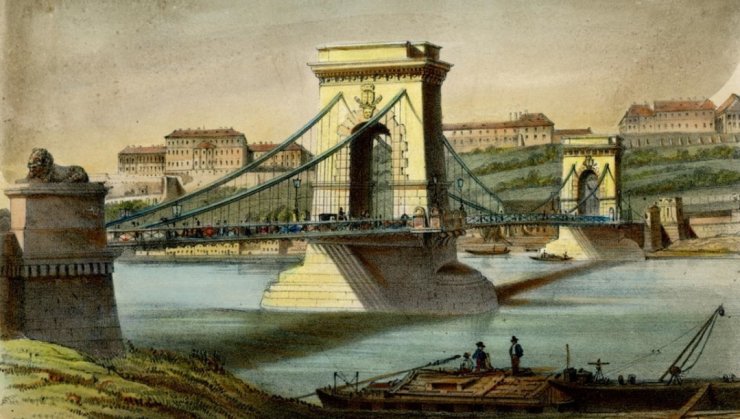

































Hozzászólások
Log in or register to comment!
Login Registration